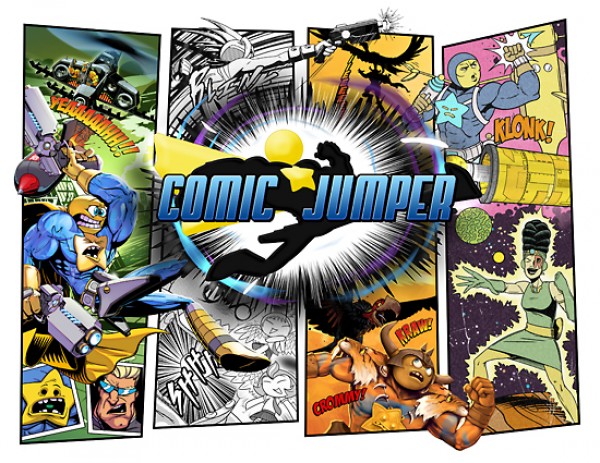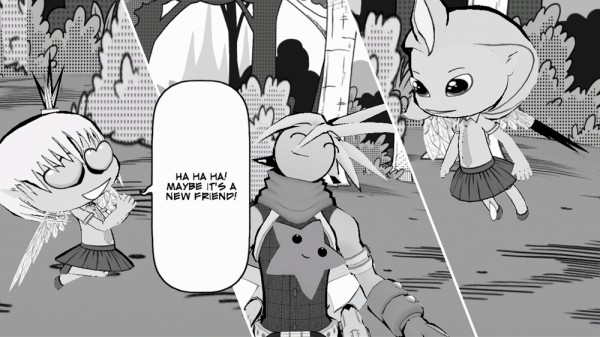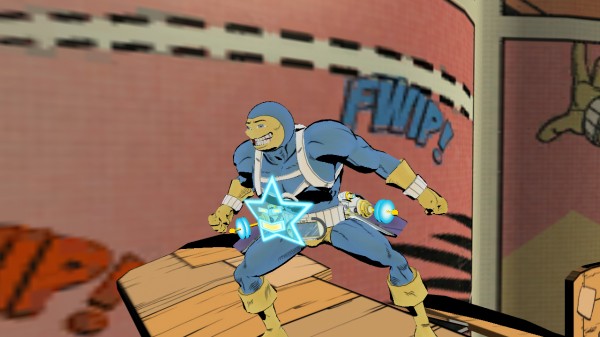Comic Jumper Review (XBLA)
Comic Jumper was developed by Twisted Pixel and published by Microsoft Game Studios for XBLA on October 6th, 2010. Retails for 1200 Microsoft Points ($15). The publisher provided a copy of the game for reviewing purposes.
Captain Smiley and his sidekick Star aren’t the greatest heroes ever created, and they damn well know it. After having their ongoing comic series canceled, the duo become guest stars for hire in other comics in order to make enough money and gain enough popularity to reclaim the spotlight that was lost to them. Comic Jumper has a lot to live up to with Twisted Pixels past two games being rather successful. They deliver an adventure that is a comedic and aesthetic hit, but has fundamental issues with pacing and level design, ultimately falling short of greatness.
Bringing their own brand of justice to each crossover, Smiley and Star will earn money by means of fan-set challenges and “righting” wrongs. Twisted Pixel themselves also play a large role in the game, even outside of creating the adventure. By destroying the fourth wall the development house provides the funding and technology to make comic jumping possible. In each new world Captain Smiley is confronted by a quirky rogue’s gallery consisting of a Duke Nukem stand-in, a feminist bondage-loving villainess, and a maniacal mini golfer. With the money earned, upgrades can be purchased at the home base to increase slide time, health, and damage.
Here’s what we liked:
Beautifully painted pages- The world of Comic Jumper really does feel like a comic book come to life. Each new series Smiley and Star cameo in have their own look and feel. Matching each genre are new character models for the heroes that fit them perfectly in with the world. From the Silver Age of comics to the pages of a Shojo Manga, every level is exactly how you would expect it to look. Battling robots in the 60’s accompanied by flat muted colors and Jack Kirby inspired characters and the hyper machismo Conan-esque world of Nanoc the Obliviator are amazingly realized. Each new chapter is a treat to jump into and should be used as precedent for future graphic novel inspired media.
Made for heroes- Comic Jumper is no joke in the difficulty department and you will most likely die over, and over, and over. While frustrating at points, it brought forth some narcissistic satisfaction when a particularly hard gauntlet is cleared by the skin of your teeth. Even more rewarding are the fan-pleasing panels that give monetary rewards for escaping a hairy situation unscathed. There isn’t any life recovery unless you die or complete a level, so being mindful of your surroundings and having quick reflexes will be your greatest assets. Yes, it can be tough at times, but there is a competent checkpoint system and infinite lives to get you back into the fight when the heroes fall. For those who are completionists there are challenge levels to earn more money and further upgrade Smiley or purchase bonus material.
Comics can be a funny thing- Twisted Pixel has a history of humor built into their games and CJ is no exception. Many times have Star’s less than PC comments made grinding through overly drawn out levels a worthwhile endeavor. Situations involving a boy made of paper lodged in Smiley’s tights asking about the birds and the bees, and finding out how messed up things from Japan can be kept a smile plastered on my face. Each new cut-scene brings with it new laughs and along with the art became one of my favorite parts of the game.
What we didn’t like-
Shoot, dodge, rinse, repeat- The challenge of the levels is not without it’s annoyances. Through much of the game you will encounter three types of enemies: Ones that run at you, ones that throw projectiles, and ones that toss fire bombs. No matter what genre you’ve jumped into, with the exception of an occasional mini-boss, you’ll be fighting a combination of the three nonstop. It doesn’t seem like too much of an issue for the first couple of levels, but once you notice the lack of diversity, each area feels like more of the same. It also doesn’t help that each level feels artificially elongated by repeated encounters in samey looking corridors. It goes on for far too long and many times made me take a break from the monotony.
A little too trigger happy- Your first round of fighting off baddies is full on fisticuffs, but when the gloves come off and guns are removed from Smiley’s holsters they stay out for the majority of the game. Close quarter combat is only used when enemies are extremely close to Captain Smiley, or when filling up the Twisted Pixel meter in specially designated encounters with mindless waves of infantry. You will want to stretch out your trigger fingers because they’ll be used a lot.
Through the four different worlds Smiley and Star run, shoot, and slide across, they find themselves out of their element into archetypal adventures filled with clever quips and challenging sequences. While each new issue you invade looks fantastic, they tend to lose their luster after overly long levels kill the fun forcing you to slog through to the next redeeming cut scene or boss fight. Much of the game does feel repetitious, but those looking for it will find fun and much to do in Comic Jumper.
Score: Try it!




